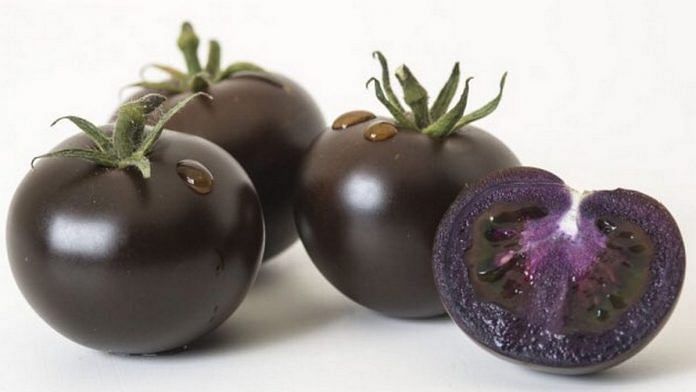New Delhi: When European scientists genetically modified a tomato with DNA from the snapdragon flower in 2008, the result was a through-and-through purple tomato with anti-cancer properties. Fourteen years later, this royal-coloured GMO (genetically modified organism) has finally been approved by US regulators.
Earlier this month, the Animal and Plant Health Inspection Service (APHIS) of the US Department of Agriculture (USDA) deemed that the plant could be safely grown and bred in America. “We found the plant is unlikely to pose an increased plant pest risk compared to other cultivated tomatoes,” the USDA said in a statement.
Whether or not customers will bite remains to be seen. But from next year, people will most likely be able to buy seeds and grow GMO tomatoes. The researchers behind it have expressed their excitement that their “healthy” creation will finally be able to make the journey to American tables.
“This is fantastic, I never thought I would see this day. We are now one step closer to my dream of sharing healthy purple tomatoes with the many people excited to eat them,” Cathie Martin, a professor at the John Innes Centre in the UK, and one of the scientists involved in the research, said in a statement.
Here is a look at why purple tomatoes may be even more nutritious than regular tomatoes and the science behind them.
Also read: Modi govt’s ‘indecisiveness’ on GM crops slowed down research advancement, US agri dept criticises
What makes purple tomatoes so ‘healthy’?
The ‘purple tomato’ was created not just for its visual appeal but for its enhanced nutritional qualities.
It was first developed in the lab 14 years ago by an international team of researchers from Italy, UK, Germany and Netherlands.
The team introduced genes from the antirrhinum — a variety of plants commonly known by names like snapdragon, dragon flower, and dog flower — to grow purple tomatoes rich in anthocyanins.
Anthocyanins are naturally occurring pigments present in particularly high levels in berries such as blackberry, cranberry and chokeberry. They don’t have a flavour or smell of their own, although their presence brings a slightly “astringent”, or acidic, taste.
More importantly, there is some evidence that anthocyanins offer protection against certain cancers, cardiovascular disease, and age-related degenerative disorders due to their anti-oxidant and anti-inflammatory properties. Studies also show that these properties make them useful in managing obesity and related conditions.
“Most people do not eat five portions of fruits and vegetables a day, but they can get more benefit from those they do eat if common fruit and veg can be developed that are higher in bioactive compounds,” Martin had said in a statement back in 2008.
The science behind the purple tomato
In 2008, in a study published in the journal Nature Biotechnology, the team described how they expressed two genes from snapdragon that induce the production of anthocyanins in snapdragon flowers.
The genes were turned on in the tomato fruit, resulting in tomatoes that had higher levels of anthocyanins than previously ever reported in either the peel or flesh of the fruit.
The resulting fruit was also an intense purple colour.
For the study, the researchers further carried out tests on cancer-susceptible mice. They found that the lifespan of such mice was significantly extended when their diet was supplemented with the purple tomatoes compared to normal red tomatoes.
Martin, along with Jonathan Jones from the Sainsbury Laboratory, went on to establish a spin-off company called Norfolk Plant Sciences in 2009 — UK’s first GM crop company. They submitted a request for regulatory approval in August last year.
“The bittersweet thing is that the tomatoes will be on sale in America and not the UK as well. But the plus side is that by focusing on home growers we will be consumer oriented, and we will be able to get feedback and interest needed to develop other products,” Martin said in the 2022 statement cited earlier.
(Edited by Asavari Singh)
Also read: Is it brinjal or tomato? No, it’s ‘Brimato’, just like ‘Pomato’ grafted by Varanasi scientists



